Agricultural Research Pesticides and Biofertilizers
OPEN ACCESS | Volume 6 - Issue 1 - 2026
ISSN No: 2994-0109 | Journal DOI: 10.61148/2994-0109/ARPB
Alka Tangri1, Anindita Bhattacharya 2* and Madhu Sahgal 3
1Department of Chemistry,Brahmanand PG College, Kanpur
2Department. of Chemistry, Christ Church College, Kanpur
3Department. of Botany, Brahmanand College, Kanpur
*Corresponding Author: Anindita Bhattacharya, Department. of Chemistry, Christ Church College, Kanpur.
Received: May 14, 2021
Accepted: May 24, 2021
Published: June 30, 2021
Citation: Tangri.A, Bhattacharya.A and Sahgal.M. (2021) “Ancient India’s Contribution to production of dyes, Perfumes and Herbal drugs.”, Journal of Agricultural Research Pesticides and Biofertilizers, 1(4); DOI:http;//doi.org/05.2021/1.1017.
Copyright: © 2021 Anindita Bhattacharya. This is an open access article distributed under the Creative Commons Attribution License, which permits unrestricted use, distribution, and reproduction in any medium, provided the original work is properly cited.
Today after a gap of one thousand years, the spirit of humanness can again breathe freely, and it is about time that we recollect it and the successes it propelled the human mind to achieve. The human mind embodied in the ancient sages, rishis, munis and sanyasis - scientists in modern parlance.
We need to remember our past clearly and vividly, lest we forget, our capability to contribute to the repository of human knowledge, lest we forget our capability to activate the indomitable human mind residing within us, lest we forget our humane instincts that gave us a sagacious and charitable view of life along with progress - economic, technological and material. All that which goes under the term civilization.
Introduction:
India has had a long tradition of spiritual development and since ancient times, foreigners especially the Greeks have been enamoured of it. Many foreigners who came to India as invaders and traders embraced Indian religions like Buddhism and Hinduism and were absorbed into Indian society. Apart from the Greeks (Yavanas), they included Persians (Para-shakas or Para-shikas - forerunners of present day Parsis), Huns (Hunas) and Mongols (Kushanas). Many emperors looked upon as Indians were actually of foreign origin. Notable among them were Milinda or Menander who was a Greek, Kanishka who was a Kushana (Mongol), Rudradaman who was a Shaka (Scythian).
But India also has a fair share in enriching the world's material culture. It is not well known that among other things; the distillation of perfumes, the making of dyes, the extraction of sugar, the weaving of cotton (muslin) cloth, and even the techniques of algebra and lgorithm, the concept of zero, the technique of surgery, the concepts of atom and relativity, the principle ofmagnetism actually utilised in making a Mariner's Compass, the herbal system of medicine, the technique of alchemy, the smelting of metals,the game of Chess, the martial art of Karate, etc., are to be found in ancient India and there are evidences which indicate that they might have originated here.
The Distillation of Perfumes:
India since ancient times and perhaps had originated here. In ancient times perfumes and fragrant ointments were of two typ viz., Teertha (liquids) and Gandha (slurries or ointments). During the coronation Kings or durlng any auspicious occasion person was sprinkled with aromatic oils. Fragrant ointments based on sandalwood were applied during ceremonial bathing. Even today during some festivals like Diwali aromatic slurries and pastes are prepared out of a powder called Sugandhi. Utne and are used during the ceremonial bath which is taken during that festival. Even in other religious rites, Sandalwood, Ochre and Camphor are traditionally used by Hindus.
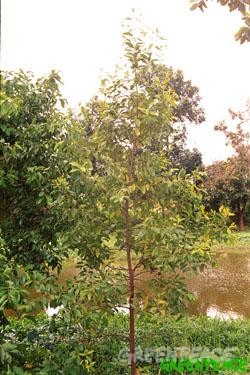
Sandalwood:
Since very early times Sandalwood and Sandalwood oil were items of export. The Greek text of the 1st century A.D., Periplus mentions sandalwood as one of the items being imported from India. The word Sandal (wood) is derived from the Latin terms Santalum Album or Santalacae. These terms used by the Romans to describe sandalwood were, according to the Oxford Dictionary, derived from the Sanskrit term Chandana, for sandalwood.

Spikenard:
Spikenard was a costly aromatic ointment extracted since ancient times from an Indian plant known in Sanskrit as Nardostachys Jatamansi which perhaps means 'the braid of hair (Jataa) of (Narada) ) Root of jatamansi has been clinically proved out as a memory enhancer and neuro-protective can be a fruitful remedy for Alzheimer’s disease.
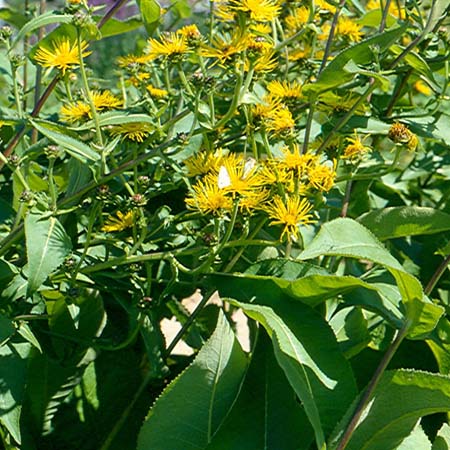
Saussurea Lappa ( costus )
Costus: Costus is the root of the plans Saussurea Lappaa tall perennial plant growing on the open slopes of the vale or Kashmir and other high valleys of that region. t was used by the Romans as a culinary spice as also as a perfume.

Macir:
Macir is mentioned by Dioscorides as an aromatic bark. Pliny says that it was brought from India. He describes it as a red bark growing upon a large root, which bears the name Macir from the tree that produced it.
Both the bark and seed of this tree were among the most important medicines in the Ayurvedic system of medicine it is derived from the Sanskrit term "Kankamon". Holarrhena Antidysenterica
Musk:
Musk is also a fragrant substance which is secreted in the gland by a male musk-deer. Musk is redish-brown in colour and is used as a base for perfumes and also as an ingredient for soaps to give it a musky smell. In Sanskrit, Musk is known as Muska which means the scortum i.e. the pouch of skin containing the testicles of the deer. The English term Musk originates from the Sanskrit term Muska according to the Oxford Dictionary.
Tamarind:
Tamarind is a fruit whose acid pulp is used in the making of cooling or medicinal drinks. The English word Tamarind is derived from the Latin term 'Tamarindus Indica' which is derived from the Arabic term Tamr-Hindi which means 'Dates from India'. The Arabs were familiar with only one form of fruit i.e. Dates, which grow in the desert. Thus, when they came across another fruit which they could use in the making of cool refreshing drinks they named it 'Dates from India' Tamr-Hindi; after the country from where they had obtained the fruit. In Sanskrit, Tamarind is called Chincha and Amlica.
Camphor:
Camphor is a whitish translucent crystalline volatile substance with aromatic smell and bitter taste. It is also used in pharmacy as a medicinal drug. The word camphor is derived from the Latin word 'Camphora' which comes from the Arabic term Kafur, which ultimately originated from the Sanskrit term Karpuram, according to the Oxford Dictionary.
The Making of Dyes and Pigments:
Many dyes and pigments were extracted in ancient India from vegetable and mineral bases. The Greek historian Ktesias who lived in the 4th century B.C. at the Persian Court has observed that their legs are of extraordinary length and soft to the touch. They grow upon trees which produce amber and subsist upon their fruit. The Indians collect them for the sake of the purple dye, which they yield when crushed. This dye is used for tinting with purple not only their outer and under-garments, but also any other substance where a purple hue is required. Robes tinted with this purple are sent to the Persian King, for Indian purple is thought by the Persians be marvellously beautiful and far superior to their own." Ktesias also says that the Indian dye is deeper and more brilliant than the renowned Lydian Purple.
Lac:
Lac is a resinous substance secreted on trees by an insect called the Lac insect. This is used as a protective covering and as varnish on wooden furniture. According to the Oxford Dictionary the English word lac is derived from the Sanskrit term Laksha which itself is derived from the word Raksha which in Sanskrit means protection. This was perhaps as lac was used as a protective covering. Lac was also used as a dye. In ancient times it was used by women for dyeing nails and palms. It was also used to dye cloth. The process of dyeing cloth with lac was termed Vastra-ranga-kruta which literally means 'to give colour to cloth’. In doing these screens were used to hold cloth in place while the dye was being applied.
Ochre:
Ochre is a pigment varying from light yellow to orange and brown. It is a mineral of clay and hydrated ferric oxide. The old name of ochre is cinnabar which was perhaps derived from the Sanskrit term Sindhura. According to the Century Dictionary, the word cinnabar originated from the Persian word zinjafr, which is a corruption of the Sanskrit Sindhura. Ochre (or cinnabar) was used as a dye for cloth and also as a paint for walls in Roman times. In India it was, and still is used to paint images of Gods and as a caste mark applied on the forehead called tilaka.

Copal:
Copal is a resin extracted from a tree which in Latin is named Vateria Indica. This tree is to be found in the Western Ghats (Hills) of India. The word copal is not to be found today in the Oxford Dictionary, but according to the Periplus, “
Aniline:
This is a blue coloured dye obtained from coal tar. This was being extracted in ancient India and was Transmitted to the west by the Arabs. It was called Neel or Neelam in Sanskrit. The Arabs named it AI Nil or A Nil from which we have the English word Aniline. This is corroborated by the Oxford Dictionary.
Indigo:
Indigo is also a blue coloured dye obtained from a plant named Indigofera. In ancient times, indigo was used both as a dye and as a medicine. The word indigo is derived from the Greek word Indikon which means 'from India'. In Sanskrit it is referred to as Neelam.

The Smelting of Metals:
According to information culled out from various Roman and Greek texts, metals like iron, tin, copper and brass were imported from India. These texts say that the metals were not being imported as an ore but as sheets. This presumes that the ore must have been smelted and cast into sheets in India before it was exported. References in Sanskrit literature also support this.
Iron:
Marco Polo has mentioned that iron and Ondanique was sold in the markets of Kerman in Iran. The word Ondanique has been interpreted as a corruption of the Persian word Hundwaniy which meant 'Indian Steel'. In ancient times, in India, Loha-churna meant iron ore; Kupya- shala and Sandhaani meant an iron foundry'. A furnace was called Chuli or Agnikund. Wrought iron was called Lohabandhan, iron bars were called Loha-pindaha. Smelting of iron was called Loha-drava-Karan (literally, liquefaction of Iron). Loha-chinha meant an iron mould and Lohakaraka meant a smith or ironmonger.
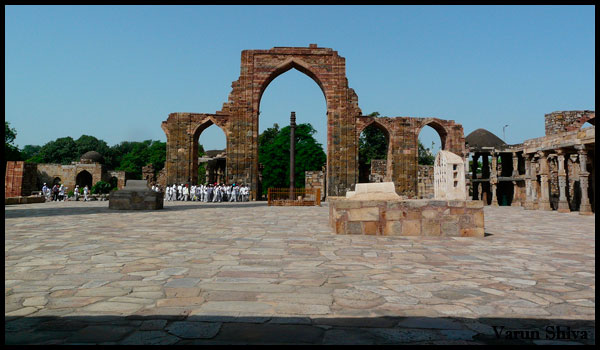
Iron Pillar of Mehrauli
Copper: Copper has been mentioned in the Periplus as an article of export from India. In those days copper ore was extracted in a big way and it was smelted locally in South India and Rajputana, according to the Periplus.
In ancient India copper was also known as Tamara, copper plate was called Tamara-Patra. Tamrakar meant a copper smith and Tamara-pana meant a copper coin.
|
|
COPPER: Copper has been mentioned in the Periplus as an article of export from India. In those days copper ore was extracted in a big way and it was smelted locally in South India and Rajputana, according to the Periplus. In ancient India copper was also known as Tamara, copper plate was called Tamara-Patra. Tamrakar meant a copper smith and Tamara-pana meant a copper coin. |
Brass:
Brass is not an original metal obtained from natural ore, it is a composite metal found as an alloy of copper and zinc. From the above quotation of Philostratus it is evident that in ancient India the art of welding metals together was known. It is possible that brass was used for decorative purposes due to its likeness to gold. Thus, we have the terms like Pitalam-Pushpakam, Pitalam Kusuman janam and Pitalam-Pushpaketu which mean efflorescence created from brass. The ornamental use of brass in ancient India is also evident from the quotation of Philosotratus given above in the section on copper.
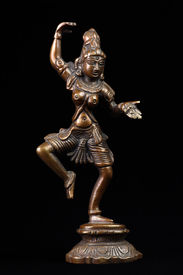
Corundum:
This unfamiliar word connotes crystallised aluminium oxide of various colours having great hardness and used as gems and also as an abrasive. We have been told that certain gems were used to cut metals in ancient India, corundum, or Kuruvinda in Sanskrit, was one such gem. Corundum was also exported from India to foreign countries since ancient times. The fact that India was the main source of this item is evident from the name Corundum given to it which according to the Oxford Dictionary is derived from the Sanskrit word Kuruvinda.
Nowshadder:
This is another unfamiliar term which means chloride of ammonium. This was also being obtained from ancient India. The word Nowshadder is also derived from a Sanskrit root word 'Narasara'.
Beryl:
This is a mineral species of a transparent precious stone varying from pale green to yellow in colour. This was one of the items of export from I ndia during early times. The word Beryl is said to have been derived from the Sanskrit term Vaidurya.
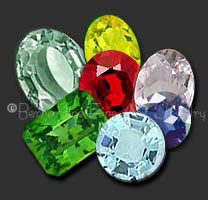
Copal:
This is an amorphous quartz like form of hydrated silica, some types of opal are semi-translucent and appear like glass. This item is recorded to have been exported in ancient times from India. The English word Opal has been derived from the Sanskrit term Upala a fact which is corroborated by the Oxford Dictionary.
The Making of Drugs and Herbal Compounds:
As India is the home of Ayurveda, the herbal system of medicine, it is but natural that many herbal compounds, drugs, antidotes, etc., should have existed in ancient India. Many foreign commentators like Megasthanes, Strabo, Xenophon and Ktesias have referred to the various drugs and medical compounds that were extracted by ancient Indians. Liquors were also exported to foreign countries since very early times. The Arabs who carried Indian commodities to western countries in ancient and medieval ages, called the Indian liquor Arak from the Sanskrit term Arka. From the Arabic term we have the English word Arrack, this is corroborated by the Oxford Dictionary.
Googul:
This unfamiliar word means an aromatic gum which is the basic input into many Ayurvedic medicines. This word was transmitted to the west through the export of Ayurvedic medicines to the Roman Empire. The word is used even today in Indian medicines as in Yograj Guggul for instance.

Chiretta:
This is the name of a plant which yields a bitter serum used as medicine by Ayurveda. The export of this item in ancient times has led to the inclusion of the word Chiretta in the medical vocabularies of western languages today. The word Chiretta is derived from the Sanskrit term, Kirata-tikta which means 'bitter plant' from Kirata'. Kirata, incidentally was the name of a province in ancient India.

Chaulmoogra:
This is the name of a tree whose seeds were used for extracting oil which was used in the treatment of leprosy in ancient India. This remedy was transmitted to foreign countries alongwith the name of the oil. The English word Chaulmoogra originates from the Indian term for it.
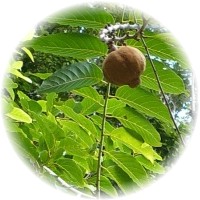
Pepper:
Pepper or Pier Longum has been referred to in the Periplus. According to the notes to the Periplus, pepper was obtained from "a perennial shrub, native of the hotter parts of India". The Latin term Piper Longum and the Greek Peperi originated from the Sanskrit term Pippali.
Ginger:
The word ginger is derived from the latin word gingiber which according to the Oxford Dictionary is derived from the Sanskrit root word Sringam which means a horn. The Oxford Dictionary has spelt the Sanskrit word as Crngam. Ginger ale and alcohol were also made from ginger in ancient India. This was called Ardraka-Madya and Panam-Madya. Madya as we know means liquor.
Cloves:
The first available reference to the Indian trade in cloves is that of Cosmas Indicosleustes who tells us in his text the Christian Topography dated around 550 A.D., that "From the inner regions, that is from Tzinista and from the other market-towns, are brought silk cloth, aloe-wood, cloves and sandalwood."
The Cultivation and Processing of Spices
India is in a way synonymous with spices; Pepper, Ginger, Cloves, Cinnamon, Coriander, Cardamom, Cumin, etc., have all been exported from India since ancient times. In fact, spices were so valuable in the west that at times when the trade routes were dislocated by wars, spices used to sell by their weight in gold. We shall see below the various spices exported from India in ancient times.

Cinnamon:
As to the country of origin of cinnamon, the father of history, Herodotus gives a fabulous story of its recovery from the nests of great birds "in those countries in which Bacchus was nursed, " which in Greek legend meant India. This is an indication that cinnamon was originally brought from India. The Sanskrit term for cinnamon which is Sugandhi-Tvacha means aromatic bark. It can be seen that the words sugandha and cinnamon are etymologically near.
Conclusion:
From this survey of the different products that were being manufactured and exported we have seen that since ancient times India had developed the mechanical arts. Metals were smelted and cast into sheets, even into pictures as was recorded by Greek historians; fabric was woven and dyed, needless to say yarn was spun to produce the finest muslin fabrics; oil was extracted from coconuts, groundnuts, palm and sesame; perfumes were made from sandalwood, musk, camphor and spikenard; dyes and pigments were extracted
from ochre, indigo, lac, and copal; sugar crystals were made, coir mats woven and even glass and imitation jewellery was manufactured. All this was not done with bare hands, technology used cannot even be considered as that of handicrafts. The techniques used in making sugar, glass, jewellery, metal sheets, oils, etc., presumed the existence of physical apparatus of some degree of sophistication.
To fabricate that physical apparatus a knowledge of mechanics and mechanical engineering was a pre-requisite. The various references to the use of spindles, oil-mills, furnaces given under various sections in this chapter throw light as to the state of mechanical- arts in ancient India which supported our export trade and enabled us to maintain a monopoly in the supply of many items for centuries together.